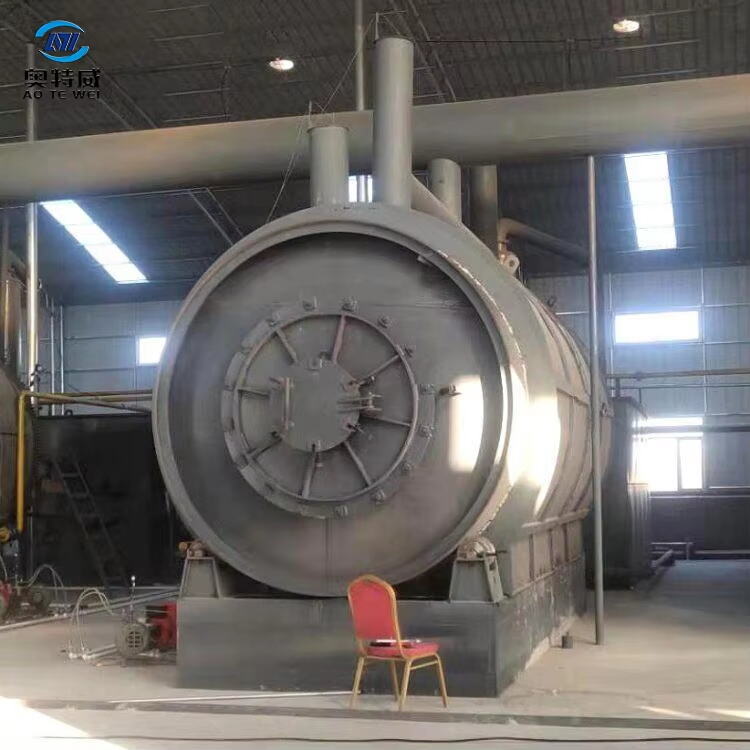Οι αυξανόμενες περιβαλλοντικές ανησυχίες σχετικά με τη διάθεση απορριπτόμενων ελαστικών έχουν οδηγήσει σε αυξημένο ενδιαφέρον για αντιδραστήρας πυρόλυσης τεχνολογία. Αυτή η καινοτόμος λύση μετατρέπει τα χαμένα ελαστικά σε πολύτιμους πόρους μέσω μιας εξελιγμένης διεργασίας θερμικής διάσπασης. Καθώς οι βιομηχανίες παγκόσμια αναζητούν βιώσιμες λύσεις διαχείρισης αποβλήτων, η επιλογή του κατάλληλου αντιδραστήρα πυρόλυσης έχει γίνει κρίσιμη για την επιτυχής λειτουργία ανακύκλωσης ελαστικών.
Η καρδιά κάθε αντιδραστήρα πυρόλυσης βρίσκεται στον σχεδιασμό του θαλάμου. Ένας καλά σχεδιασμένος θάλαμος αντίδρασης εξασφαλίζει βέλτιστη κατανομή θερμοκρασίας και επεξεργασία των υλικών. Η κατασκευή από χάλυβα υψηλής ποιότητας με κατάλληλη μόνωση μεγιστοποιεί τη θερμική απόδοση, διατηρώντας παράλληλα τα πρότυπα ασφάλειας. Ο θάλαμος πρέπει να αντέχει σε υψηλές θερμοκρασίες και μεταβολές πίεσης κατά τη διάρκεια της διαδικασίας πυρόλυσης.
Οι σύγχρονοι σχεδιασμοί αντιδραστήρων πυρόλυσης περιλαμβάνουν προηγμένα χαρακτηριστικά, όπως αυτόματα συστήματα τροφοδοσίας και ακριβείς μηχανισμούς ελέγχου θερμοκρασίας. Αυτά τα στοιχεία συμβάλλουν στη σταθερή ποιότητα του προϊόντος και στην επιχειρησιακή απόδοση. Το μέγεθος και η διαμόρφωση του θαλάμου επηρεάζουν άμεσα την χωρητικότητα επεξεργασίας και την απόδοση του τελικού προϊόντος.
Το σύστημα θέρμανσης καθορίζει την απόδοση και την ενεργειακή απόδοση της αντίδρασης. Διαφορετικές μέθοδοι θέρμανσης, όπως έμμεση θέρμανση, άμεση θέρμανση και θέρμανση με μικροκύματα, παρέχουν διαφορετικά πλεονεκτήματα. Τα συστήματα έμμεσης θέρμανσης παρέχουν καλύτερο έλεγχο της θερμοκρασίας και μειώνουν τον κίνδυνο μόλυνσης, ενώ τα συστήματα άμεσης θέρμανσης μπορεί να προσφέρουν υψηλότερη ενεργειακή απόδοση.
Τα συστήματα παρακολούθησης και ελέγχου της θερμοκρασίας διαδραματίζουν σημαντικό ρόλο στη διατήρηση των βέλτιστων συνθηκών πυρόλυσης. Οι προηγμένοι αντιδραστήρες διαθέτουν πολλαπλούς αισθητήρες θερμοκρασίας και αυτοματοποιημένα συστήματα ελέγχου για να εξασφαλίσουν ακριβή θερμική διαχείριση καθ' όλη τη διάρκεια της διαδικασίας.

Κατά την επιλογή ενός αντιδραστήρα πυρόλυσης, η επεξεργασία της χωρητικότητας αποτελεί πρωταρχική προτεραιότητα. Η παροχέτευση του αντιδραστήρα πρέπει να ευθυγραμμίζεται με τις επιχειρησιακές σας απαιτήσεις και την κλίμακα της δραστηριότητάς σας. Μικρής κλίμακας εγκαταστάσεις μπορούν να επωφεληθούν από αντιδραστήρες παρτίδας που επεξεργάζονται 5-10 τόνους την ημέρα, ενώ βιομηχανικές εγκαταστάσεις συχνά απαιτούν συνεχείς αντιδραστήρες που χειρίζονται 20-50 τόνους ημερησίως.
Λάβετε υπόψη σας τα σχέδια για μελλοντική επέκταση κατά τον προσδιορισμό των απαιτήσεων σε χωρητικότητα. Ένας μοντουλικός σχεδιασμός επιτρέπει επεκτασιμότητα, δίνοντας τη δυνατότητα στις επιχειρήσεις να αυξήσουν την επεξεργαστική ισχύ καθώς αυξάνεται η ζήτηση. Η αποτελεσματικότητα του αντιδραστήρα στη διαχείριση μεταβαλλόμενων συνθηκών φόρτωσης επηρεάζει επίσης τη συνολική επιχειρησιακή ευελιξία.
Η κατανάλωση ενέργειας επηρεάζει σημαντικά το κόστος λειτουργίας και το περιβαλλοντικό αποτύπωμα. Οι σύγχρονοι αντιδραστήρες πυρόλυσης περιλαμβάνουν συστήματα ανάκτησης θερμότητας και βελτιωμένη μόνωση για τη μεγιστοποίηση της ενεργειακής απόδοσης. Συγκρίνετε διαφορετικά μοντέλα με βάση την κατανάλωση ενέργειας ανά τόνο επεξεργασμένου υλικού.
Αξιολογήστε τον λόγο χρησιμοποίησης θερμότητας του αντιδραστήρα και τις δυνατότητες θερμικής ανάκτησης. Τα συστήματα με ενσωματωμένους εναλλάκτες θερμότητας και μηχανισμούς ανάκτησης θερμότητας απορριμμάτων παρέχουν καλύτερη οικονομία λειτουργίας και μειωμένο επίπεδο περιβαλλοντικής επίδρασης.
Η αντοχή και η διάρκεια ζωής ενός αντιδραστήρα πυρόλυσης εξαρτάται σε μεγάλο βαθμό από τα υλικά κατασκευής. Κράματα ανθεκτικά σε υψηλές θερμοκρασίες και οι κατάλληλες τεχνικές συγκόλλησης εξασφαλίζουν την ακεραιότητα του αντιδραστήρα σε ακραίες συνθήκες. Αναζητήστε αντιδραστήρες που κατασκευάζονται σύμφωνα με διεθνή πρότυπα και διαθέτουν πιστοποιημένη ποιότητα υλικών.
Η αντοχή στη διάβρωση γίνεται ιδιαίτερα σημαντική λόγω της επιθετικής φύσης των προϊόντων πυρόλυσης. Προηγμένες τεχνολογίες επικάλυψης και η επιλογή των υλικών θα πρέπει να αντιμετωπίζουν τόσο τις χημικές όσο και τις θερμικές απαιτήσεις.
Τα χαρακτηριστικά ασφάλειας είναι απαραίτητα κατά την επιλογή αντιδραστήρα πυρόλυσης. Τα σύγχρονα συστήματα περιλαμβάνουν μηχανισμούς έκτακτης διακοπής λειτουργίας, βαλβίδες αποσυμπίεσης και ολοκληρωμένα συστήματα παρακολούθησης. Οι αυτόματοι έλεγχοι ασφάλειας προλαμβάνουν τη ζημιά του εξοπλισμού και εξασφαλίζουν την ασφάλεια του χειριστή.
Επιζητήστε αντιδραστήρες με περιττά συστήματα ασφάλειας και μηχανισμούς ασφαλείας. Οι ψηφιακές διεπαφές ελέγχου με δυνατότητες παρακολούθησης σε πραγματικό χρόνο ενισχύουν την ασφάλεια κατά τη λειτουργία και παρέχουν σημαντικά δεδομένα διεργασίας για βελτιστοποίηση.
Οι περιβαλλοντικοί κανονισμοί απαιτούν αποτελεσματικό έλεγχο των εκπομπών στις διεργασίες πυρόλυσης. Οι σύγχρονοι αντιδραστήρες διαθέτουν εξελιγμένα συστήματα καθαρισμού αερίων και καταλυτικούς μετατροπείς για την ελαχιστοποίηση του περιβαλλοντικού αντίκτυπου. Αξιολογήστε την αποτελεσματικότητα των συστημάτων ελέγχου των εκπομπών και τη συμμόρφωσή τους με τους τοπικούς κανονισμούς.
Λάβετε υπόψη τη δυνατότητα του αντιδραστήρα να αντιμετωπίζει διαφορετικούς τύπους εκπομπών και την προσαρμοστικότητά του στα εξελισσόμενα περιβαλλοντικά πρότυπα. Τα προηγμένα συστήματα παρακολούθησης βοηθούν στη διατήρηση της συμμόρφωσης και στη βέλτιστη διαχείριση των εκπομπών.
Ην αποτελεσματική διαχείριση αποβλήτων ξεπερνά την ίδια τη διαδικασία πυρόλυσης. Επιλέξτε αντιδραστήρες με ενσωματωμένα συστήματα για τη διαχείριση υπολειμματικών υλικών και παραπροϊόντων. Η δυνατότητα μεγιστοποίησης της ανάκτησης πόρων, ενώ ελαχιστοποιείται η ανάγκη διάθεσης αποβλήτων, επηρεάζει τόσο τη συμμόρφωση προς περιβαλλοντικές προδιαγραφές, όσο και τα λειτουργικά έξοδα.
Λάβετε υπόψη συστήματα που προσφέρουν ευελιξία στην επεξεργασία διαφορετικών ροών αποβλήτων και στην παραγωγή διαφόρων πολύτιμων τελικών προϊόντων. Η πολυμορφία αυτή ενισχύει την προσαρμοστικότητα της εγκατάστασης στις συνθήκες της αγοράς και στις κανονιστικές απαιτήσεις.
Η απόδοση του αντιδραστήρα εξαρτάται από πολλούς παράγοντες, όπως η θερμοκρασιακή ρύθμιση, ο χρόνος παραμονής, η ποιότητα της πρώτης ύλης και η συντήρηση του συστήματος. Για τη βέλτιστη λειτουργία απαιτείται προσεκτική παρακολούθηση αυτών των παραμέτρων και τακτική βελτιστοποίηση του συστήματος με βάση τα δεδομένα απόδοσης.
Οι ανάγκες συντήρησης διαφοροποιούνται σημαντικά μεταξύ αντιδραστήρων διαλείποντος και συνεχούς λειτουργίας. Τα συνεχή συστήματα απαιτούν κατά κανόνα πιο συχνή προληπτική συντήρηση, αλλά παρέχουν υψηλότερη παραγωγική δυνατότητα. Οι αντιδραστήρες διαλείποντος λειτουργίας μπορεί να έχουν απλούστερες απαιτήσεις συντήρησης, αλλά μικρότερη δυνατότητα επεξεργασίας.
Οι παράγοντες που πρέπει να ληφθούν υπόψη περιλαμβάνουν τον απαιτούμενο χώρο, τις συνδέσεις υποδομών, τις οικολογικές άδειες και τις ανάγκες εκπαίδευσης των χειριστών. Η κατάλληλη προετοιμασία της θέσης και ο σχεδιασμός της υποδομής εξασφαλίζουν ομαλή εφαρμογή και βέλτιστη απόδοση του συστήματος.
 Τελευταία Νέα
Τελευταία Νέα2024-09-25
2024-09-18
2024-09-12
2024-09-05
2024-08-30
2024-08-23

Δικαιώματα πνευματικής ιδιοκτησίας © 2025 από την Shangqiu AOTEWEI environmental protection equipment Co.,LTD Πολιτική απορρήτου